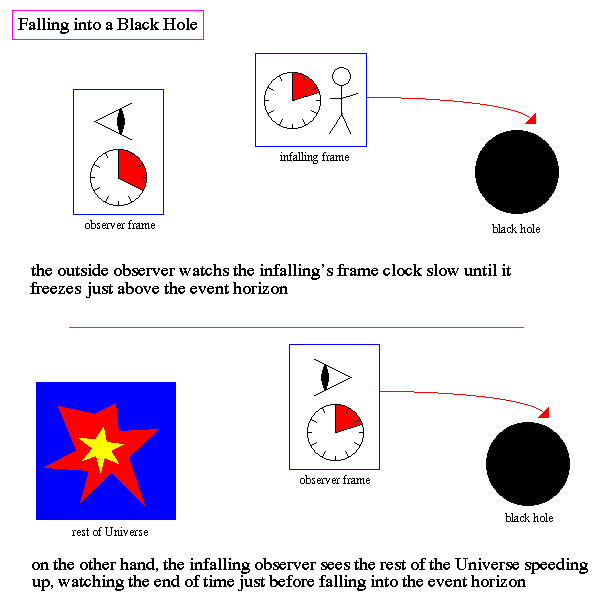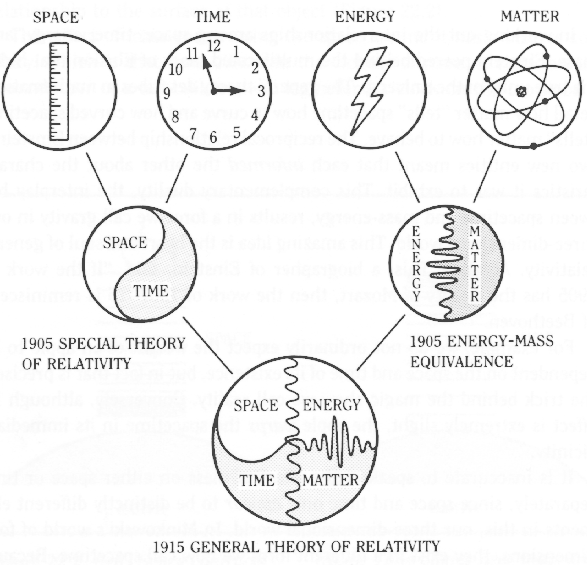
|
Special relativity and E=mc2 led to the most powerful unification of physical concepts since the time of Newton. The previously separate ideas of space, time, energy and mass were linked by special relativity, although without a clear understanding of how they were linked. |

.. |
.. The how and why remained to the domain of what is called general relativity, a complete theory of gravity using the geometry of spacetime. The origin of general relativity lies in Einstein's attempt to apply special relativity in accelerated frames of reference. Remember that the conclusions of relativity were founded for inertial frames, i.e. ones that move only at a uniform velocity. Adding acceleration was a complication that took Einstein 10 years to formulate. |
|
The equivalence
principle was Einstein's `Newton's apple' insight to gravitation. His
thought experiment was the following, imagine two elevators, one at rest
of the Earth's surface, one accelerating in space. To an observer inside
the elevator (no windows) there is no physical experiment that he/she
could perform to differentiate between the two scenarios.
.. The equivalence principle is a fundamental law of physics that states that gravitational and inertial forces are of a similar nature and often indistinguishable. In the Newtonian form it asserts, in effect, that, within a windowless laboratory freely falling in a uniform gravitational field, experimenters would be unaware that the laboratory is in a state of nonuniform motion. All dynamical experiments yield the same results as obtained in an inertial state of uniform motion unaffected by gravity. |
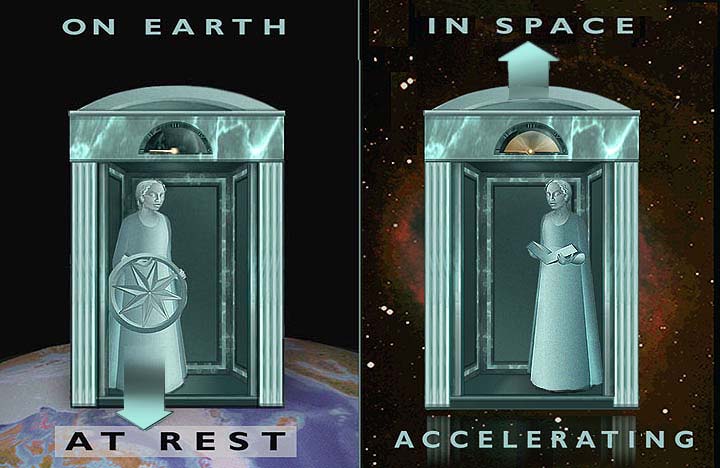
.. |
.. An immediate consequence of the equivalence principle is that gravity bends light. To visualize why this is true imagine a photon crossing the elevator accelerating into space. As the photon crosses the elevator, the floor is accelerated upward and the photon appears to fall downward. The same must be true in a gravitational field by the equivalence principle. .. The principle of equivalence renders the gravitational field fundamentally different from all other force fields encountered in nature. The new theory of gravitation, the general theory of relativity, adopts this characteristic of the gravitational field as its foundation. |
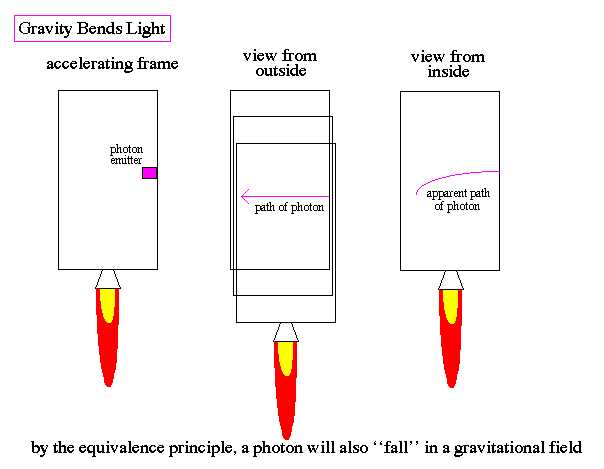
|
The second part of relativity is the theory
of general relativity and lies on two empirical findings that he
elevated to the status of basic postulates. The first postulate is the
relativity principle: local physics is governed by the theory of special
relativity. The second postulate is the equivalence principle: there is no
way for an observer to distinguish locally between gravity and
acceleration.
.. The general theory of relativity derives its origin from the need to extend the new space and time concepts of the special theory of relativity from the domain of electric and magnetic phenomena to all of physics and, particularly, to the theory of gravitation. As space and time relations underlie all physical phenomena, it is conceptually intolerable to have to use mutually contradictory notions of space and time in dealing with different kinds of interactions, particularly in view of the fact that the same particles may interact with each other in several different ways--electromagnetically, gravitationally, and by way of so-called nuclear forces. .. Newton's explanation of gravitational interactions must be considered one of the most successful physical theories of all time. It accounts for the motions of all the constituents of the solar system with uncanny accuracy, permitting, for instance, the prediction of eclipses hundreds of years ahead. But Newton's theory visualizes the gravitational pull that the Sun exerts on the planets and the pull that the planets in turn exert on their moons and on each other as taking place instantaneously over the vast distances of interplanetary space, whereas according to relativistic notions of space and time any and all interactions cannot spread faster than the speed of light. The difference may be unimportant, for practical reasons, as all of the members of the solar system move at relative speeds far less than 1/1,000 of the speed of light; nevertheless, relativistic space-time and Newton's instantaneous action at a distance are fundamentally incompatible. Hence Einstein set out to develop a theory of gravitation that would be consistent with relativity. |
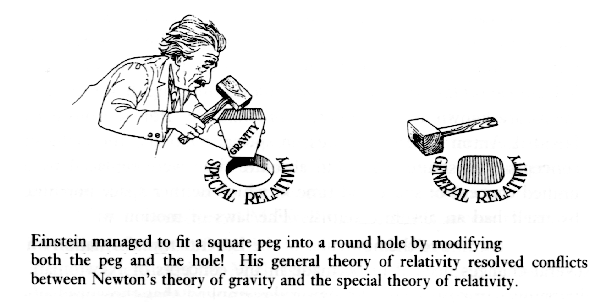
.. |
.. Proceeding on the basis of the experience gained from Maxwell's theory of the electric field, Einstein postulated the existence of a gravitational field that propagates at the speed of light, c, and that will mediate an attraction as closely as possible equal to the attraction obtained from Newton's theory. From the outset it was clear that mathematically a field theory of gravitation would be more involved than that of electricity and magnetism. Whereas the sources of the electric field, the electric charges of particles, have values independent of the state of motion of the instruments by which these charges are measured, the source of the gravitational field, the mass of a particle, varies with the speed of the particle relative to the frame of reference in which it is determined and hence will have different values in different frames of reference. This complicating factor introduces into the task of constructing a relativistic theory of the gravitational field a measure of ambiguity, which Einstein resolved eventually by invoking the principle of equivalence. .. Einstein discovered that there is a relationship between mass, gravity and spacetime. Mass distorts spacetime, causing it to curve. Gravity can be described as motion caused in curved spacetime . |

.. |
.. Thus, the primary result from general relativity is that gravitation is a purely geometric consequence of the properties of spacetime. Special relativity destroyed classical physics view of absolute space and time, general relativity dismantles the idea that spacetime is described by Euclidean or plane geometry. In this sense, general relativity is a field theory, relating Newton's law of gravity to the field nature of spacetime, which can be curved. .. Gravity in general relativity is described in terms of curved spacetime. The idea that spacetime is distorted by motion, as in special relativity, is extended to gravity by the equivalence principle. Gravity comes from matter, so the presence of matter causes distortions or warps in spacetime. Matter tells spacetime how to curve, and spacetime tells matter how to move (orbits). |
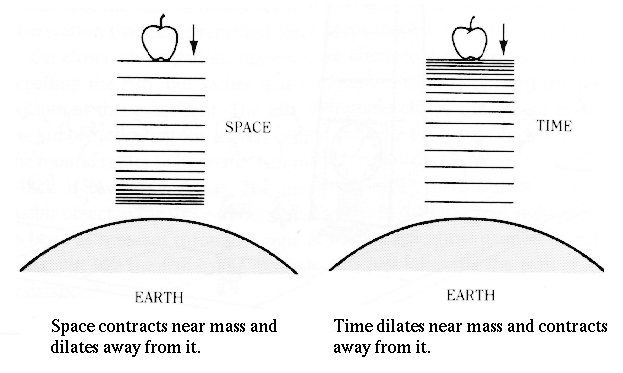
.. |
.. There were two classical test of general relativity, the first was that light should be deflected by passing close to a massive body. The first opportunity occurred during a total eclipse of the Sun in 1919. .. Measurements of stellar positions near the darkened solar limb proved Einstein was right. Direct confirmation of gravitational lensing was obtained by the Hubble Space Telescope last year. |
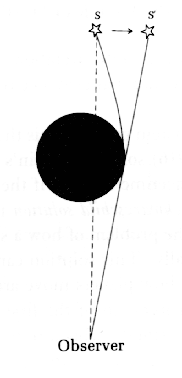
.. |
.. The second test is that general relativity predicts a time dilation in a gravitational field, so that, relative to someone outside of the field, clocks (or atomic processes) go slowly. This was confirmed with atomic clocks flying airplanes in the mid-1970's. .. The general theory of relativity is constructed so that its results are approximately the same as those of Newton's theories as long as the velocities of all bodies interacting with each other gravitationally are small compared with the speed of light--i.e., as long as the gravitational fields involved are weak. The latter requirement may be stated roughly in terms of the escape velocity. A gravitational field is considered strong if the escape velocity approaches the speed of light, weak if it is much smaller. All gravitational fields encountered in the solar system are weak in this sense. .. Notice that at low speeds and weak gravitational fields, general and special relativity reduce to Newtonian physics, i.e. everyday experience. |
|
The fact that light is bent by a gravitational field brings up the following thought experiment. Imagine adding mass to a body. As the mass increases, so does the gravitational pull and objects require more energy to reach escape velocity. When the mass is sufficiently high enough that the velocity needed to escape is greater than the speed of light we say that a black hole has been created. |
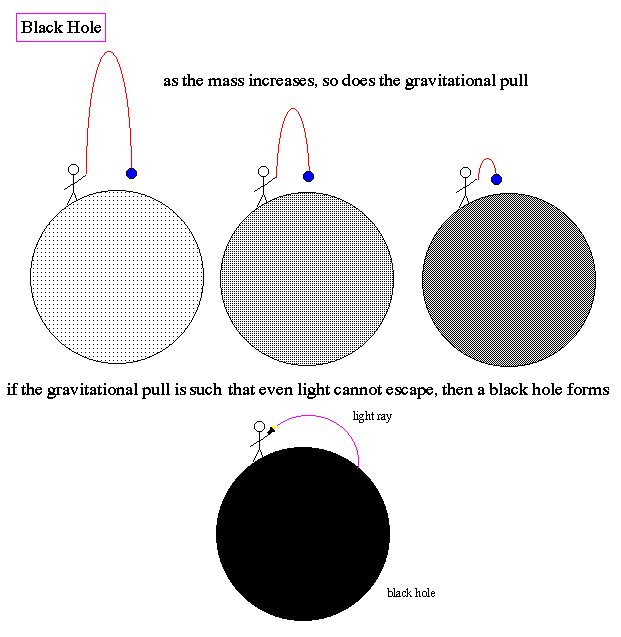
.. |
.. Another way of defining a black hole is that for a given mass, there is a radius where if all the mass is compressed within this radius the curvature of spacetime becomes infinite and the object is surrounded by an event horizon. This radius called the Schwarzschild radius and varys with the mass of the object (large mass objects have large Schwarzschild radii, small mass objects have small Schwarzschild radii). .. Schwarzschild radius is the radius below which the gravitational attraction between the particles of a body must cause it to undergo irreversible gravitational collapse. This phenomenon is thought to be the final fate of the more massive stars. .. The gravitational radius (R) of an object of mass M is given by the following formula, in which G is the universal gravitational constant and c is the speed of light: R = 2GM/c2 . For a mass as small as a human being, the gravitational radius is of the order of 10-23 cm, much smaller than the nucleus of an atom; for a typical star such as the Sun, it is about 3 km (2 miles). |

.. |
.. The Schwarzschild radius marks the point where the event horizon forms, below this radius no light escapes. The visual image of a black hole is one of a dark spot in space with no radiation emitted. Any radiation falling on the black hole is not reflected but rather absorbed, and starlight from behind the black hole is lensed. |
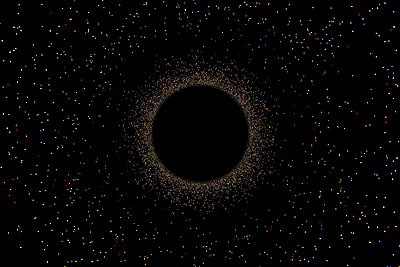
.. |
.. Even though a black hole is invisible, it has properties and structure. The boundary surrounding the black hole at the Schwarzschild radius is called the event horizon, events below this limit are not observed. Since the forces of matter can not overcome the force of gravity, all the mass of a black hole compresses to infinity at the very center, called the singularity. |
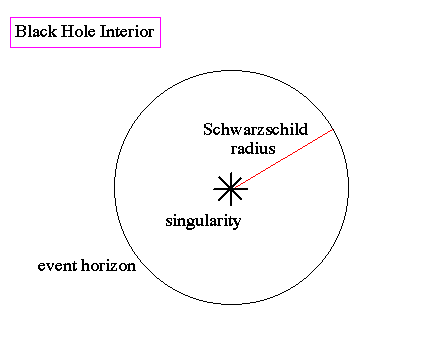
.. |
.. A black hole can come in any size. Stellar mass black holes are thought to form from supernova events, and have radii of 5 km. Galactic black hole in the cores of some galaxies, millions of solar masses and the radius of a solar system, are built up over time by cannibalizing stars. Mini black holes formed in the early Universe (due to tremendous pressures) down to masses of asteroids with radii the size of a grain of sand. |

.. |
.. Note that a black hole is the ultimate entropy sink since all information or objects that enter a black hole never return. If an observer entered a black hole to look for the missing information, he/she would be unable to communicate their findings outside the event horizon. |
